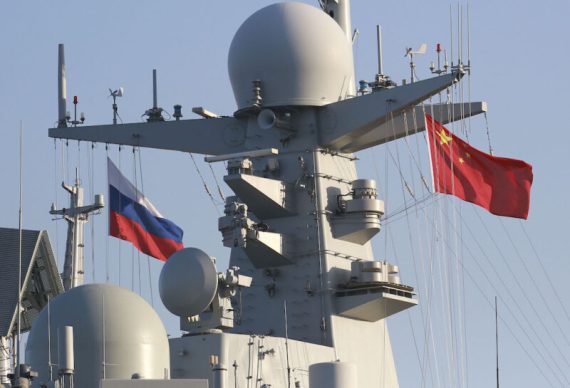A
laska, under Russian control until 1867, has recently become the focus of international attention after Russian and Chinese warships conducted joint patrols near the Aleutian Islands on August 6.
Historically, Alaska’s importance is rooted in its status as a former Russian territory and as sourcing a quarter of U.S. oil needs. The Crimean War of 1853-1856 inflicted significant financial losses on the Soviet Union, leading it to cede control of Alaska to the United States in 1867 for $7.2 million due to resource shortages and difficulty to defend. Alaska’s importance was enhanced by the Klondike Gold Rush of the 1870s, drawing numerous prospectors to the region after extensive gold deposits were discovered.
Joint Russian-Chinese naval maneuvers raise alarms
Recent developments in the region center around the joint patrols of eleven Russian and Chinese warships in the vicinity of the Aleutian Islands. The flotilla included two Chinese Navy Type 052D guided missile destroyers, two Type 054A guided missile frigates, and a Type 903 comprehensive replenishment ship.
Simultaneously, reports from the Global Times suggest that the Russian navy’s contribution to the flotilla included significant anti-submarine ships and corvettes. In response, the United States dispatched four U.S. Navy destroyers and P-8 Poseidon aircraft on August 7, 2023. However, reports confirm that the Russian and Chinese ships did not breach U.S. territorial waters during their joint maneuvers.
Echoing past operations
This is not the first instance of Russia and China cooperating in naval operations in the Pacific. In 2015, as reported by the U.S. Naval Institute News, five People’s Liberation Army Navy (PLA Navy) ships had transited the Aleutian Islands chain without mishap and in compliance. According to the report, this transit, which was 12 nautical miles from the Aleutian Islands, was classified as an “innocent passage.” Similarly, in August 2021, the U.S. Coast Guard reported seeing a Chinese naval force consisting of four ships, led by a 10,000-ton Type 055 large destroyer, in the U.S. Exclusive Economic Zone near the Aleutian Islands.
In September 2022, a formation of seven Chinese and Russian ships were spotted together up to 200 nautical miles off the Aleutian Islands by the U.S. Coast Guard. During a routine Bering Sea patrol, the U.S. Coast Guard cutter Kimball encountered a People’s Republic of China guided missile cruiser near Kiska Island, Alaska.
The U.S. Coast Guard subsequently identified two other Chinese naval vessels and four Russian naval ships, including a destroyer. Rear Admiral Nathan Moore of the U.S. Coast Guard said at the time that the formation complied with international rules, but also emphasized the principle of “presence with presence” that would be applied to protect U.S. maritime interests in the Alaska region.
Maritime borders
At the time, only one U.S. Coast Guard cutter was stationed there. According to the Wall Street Journal, the destroyers USS John S. McCain, USS Benfold, USS John Finn, and USS Chung-Hoon, as well as a U.S. P-8 maritime patrol aircraft are currently deployed near Alaska.
On the other hand, U.S. warships have frequently crossed into Chinese territorial seas in the South China Sea. The destroyers USS John S. McCain, USS Benfold, USS John Finn, and USS Chung-Hoon, accompanied by a P-8 maritime patrol aircraft, have previously transited the Taiwan Strait. Within this group, the USS John S. McCain, USS Benfold, and USS Chung-Hoon were subsequently removed for unlawful entry into Chinese territorial waters in the South China Sea.
U.S. Senator Lisa Murkowski emphasized the geographic significance of Alaska’s proximity to China and Russia, calling it a “stark reminder.” Senator Dan Sullivan expressed concern about what he called an “incursion” of 11 Chinese and Russian warships operating together off the Alaskan coast, suggesting that this event signals a new era of authoritarian aggression led by Beijing and Moscow. He advocated for a more robust U.S. military response in the event of another joint naval operation of this nature.
Recommended
Securing strategic passages
Brent Sadler, a senior research fellow at the Heritage Foundation and a retired navy captain, described the joint patrols as a “historic first.” He pointed out that heightened tensions surrounding the war in Ukraine and concerns about Taiwan make this move by Russia and China seem highly provocative.
Chinese Defense Ministry Spokesperson Senior Colonel Tan Kefei stated in a regular press conference on July 27 that the “Northern/Interaction-2023” collaborative drills and subsequent joint naval patrol are a clear expression of the strong strategic trust between China and Russia. He stressed that these missions further strengthen the long-standing cooperation between the Russian and Chinese armed forces. Tan reiterated China’s commitment to promoting effective dialogue and cooperation with all interested parties to contribute to maintaining regional peace and stability effectively.
Joint naval operations, while nothing new in the Pacific, are taking on renewed importance in the context of current global tensions. The intrusion of military vessels is a reflection of broader shifts in power dynamics and reflects strategic cooperation between Moscow and Beijing. As nations commit to regional peace and stability, the evolving maritime theater around Alaska is indicative of the ongoing interplay of interests, strategies, and potential turning points on the international stage.
Alaska continues to be an outpost where the past, present, and future of global power dynamics come together in terms of history and geopolitics. The importance of the region remains, as warships continue to transit the waters near the Aleutian Islands and new pieces come into play on the geopolitical chessboard.





